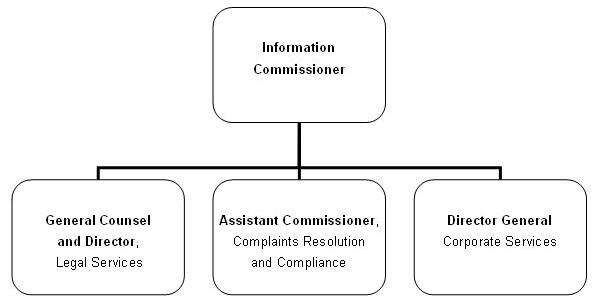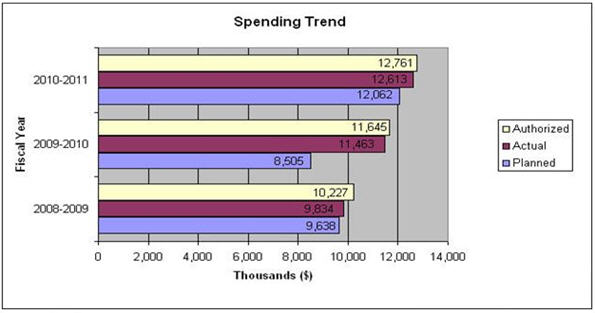Common menu bar links
Breadcrumb Trail
ARCHIVED - Office of the Information Commissioner of Canada - Report
 This page has been archived.
This page has been archived.
Archived Content
Information identified as archived on the Web is for reference, research or recordkeeping purposes. It has not been altered or updated after the date of archiving. Web pages that are archived on the Web are not subject to the Government of Canada Web Standards. As per the Communications Policy of the Government of Canada, you can request alternate formats on the "Contact Us" page.
Message from the Information Commissioner of Canada

I am pleased to present the Office of the Information Commissioner's Departmental Performance Report for 2010–2011.
As I assumed the role of Commissioner on June 30, 2010, I committed to achieving a high level of performance in investigating access complaints and issues. Hand in hand with that went strengthening our investigative and legal capacity. I also sought to enhance our governance structures and processes.
Overall, we made progress in these three areas, although we still have work to do.
Our performance, by some measures, has indeed improved. Our inventory of complaints is down, as is the overall time to investigate complaints. However, we have a way to go to achieve the level of service Canadians deserve. This will require us to take concrete steps to bring discipline to the management of our caseload and to adjust our approach to investigating complaints.
We are building investigative and legal capacity through recruitment and targeted training of employees, and by developing modern tools and systems to support them. Our efforts in this area will continue in 2011–2012, as we strive to better meet the challenges of complex cases and pursue litigation. The demands on the legal team are likely to be considerable, as the ramifications of recent Supreme Court decisions on access to records in ministers' and the Prime Minister's Office become clearer, and as requesters and institutions continue to test the limits of the exemptions and exclusions brought in under the Federal Accountability Act.
Ongoing improvement will be grounded in strong and effective governance-in particular, through our 2011–2014 strategic plan. Developing the plan in 2010 brought the whole organization together to focus on upcoming priorities and craft a clear direction for our work. The plan centres on three areas: achieving high performance by further increasing operational efficiencies; influencing the access regime and fostering self-discipline among institutions to reverse the declining trends in timeliness and disclosure; and building a workplace of choice. In line with the strategic plan, we also amended our Management, Resources and Results Structure and developed new performance targets for the 2012–2013 reporting cycle.
The importance of effective governance for me and for our organization cannot be overstated. It is essential that we act prudently and responsibly at all times to make the best use of our limited resources to provide exemplary service.
Canadians need and want us to promote government transparency and accountability. Our strategic plan will guide us in making wise investments in key areas of our program while making use of the full range of tools under our compliance continuum to maximize compliance. In this manner, we will continue to effectively assist Parliament, call central agencies and institutions to account and help Canadians obtain the information they seek.
Section I: Organizational Overview
Raison d'être
The Office of the Information Commissioner of Canada (OIC) ensures that federal institutions respect the rights that the Access to Information Act confers to information requesters. Protecting and advancing the right of access to public sector information ultimately enhances the transparency and accountability of the federal government.
Responsibilities
The OIC is an independent public body set up in 1983 under the Access to Information Act. Our mission is to conduct efficient, fair and confidential investigations into complaints about federal institutions' handling of access to information requests. The goal is to maximize compliance with the Act while fostering disclosure of public sector information using the full range of tools, activities and powers at the Commissioner's disposal, from information and mediation to persuasion and litigation, where required.
We use mediation and persuasion to resolve complaints. In doing so, we give complainants, heads of federal institutions and all third parties affected by complaints an opportunity to make representations. We encourage institutions to disclose information as a matter of course and to respect Canadians' rights to request and receive information, in the name of transparency and accountability. We bring cases to the Federal Court of Canada to advance the legal interpretation of the Act in order to maximize disclosure of information.
We also support the Information Commissioner in her advisory role to Parliament and parliamentary committees on all access to information matters. We actively make the case for greater freedom of information in Canada through targeted initiatives such as Right to Know Week, and ongoing dialogue with Canadians, Parliament and federal institutions.
The following diagram shows the OIC's organizational structure.

Legal Services represents the Commissioner in court and provides legal advice on investigations, legislative issues and administrative matters. It closely monitors the range of cases having potential litigation ramifications for us and for access to information in general. Legal Services also assists investigators by providing them with up-to-date and customized reference tools on the evolving technicalities of the case law.
The Complaints Resolution and Compliance Branch investigates individual complaints about the processing of access requests, conducts dispute resolution activities and makes formal recommendations to institutions, as required. It also assesses federal institutions' compliance with their obligations, carries out systemic investigations and analysis, and provides policy direction.
Corporate Services provides strategic and corporate leadership in human resources and financial management, internal audit as well as information management and technology. It conducts our external relations with a wide range of stakeholders, notably Parliament, government and representatives of the media. It is also responsible for managing our access to information and privacy function.
Strategic Outcome and Program Activities
| Strategic Outcome | Program Activities |
|---|---|
|
Individuals' rights under the Access to Information Act are safeguarded. |
|
Organizational Priorities
Our 2010–2011 operational priorities focused on ways to improve our service delivery and improve our management practices, controls and infrastructure. We also strove to foster greater compliance with the Act among federal institutions and to be a catalyst for modernizing the access legislation.
| Priority | Type | Status [1] |
|---|---|---|
|
1. Continue to improve service delivery to individuals who have filed complaints with the Information Commissioner. |
Ongoing | Mostly met |
| Priority | Type | Status |
|---|---|---|
|
2. Foster institutions' compliance with their obligations under the Access to Information Act by pursuing the implementation of the OIC's Three-Year Plan for Report Cards. |
New | Met all |
| Priority | Type | Status |
|---|---|---|
|
3. Maximize compliance with the Act, notably by demonstrating best practices in proactive disclosure and fulfilling the statutory duty to assist information requestors. |
Ongoing | Mostly met |
| Priority | Type | Status |
|---|---|---|
|
4. Serve as an exemplary model for the access to information process. |
Ongoing | Mostly met |
| Priority | Type | Status |
|---|---|---|
|
5. Continue to advance the cause of reforming the access to information regime by providing ongoing support and advice to Parliament and parliamentary committees. |
Ongoing | Mostly met |
| Priority | Type | Status |
|---|---|---|
|
6. Build organizational capacity. |
Ongoing | Mostly met |
In line with our 2011–2014 strategic plan, which we developed this year, we amended our Management, Resources and Results Structure (MRRS). We streamlined our priorities according to three key result areas: a leading access to information regime; exemplary service delivery to Canadians; and an exceptional workplace. We developed performance indicators that better reflect our work and represent solid and realistic targets against which we can measure our performance each year. These new targets will come into effect for the 2012–2013 reporting cycle.
Risk Analysis
The factors we noted in our 2010–2011 Report on Plans and Priorities as affecting our operating environment remained in play throughout the year. New technology and steps by government towards "open data" and "open government" continue to shape the world of access and the expectations of citizens about the information to which they may have access.
We also identified three specific risks for the year. First, we had insufficient human resources capacity, due to the number of new employees we had recruited since 2009. Among investigators, for example, 57 percent had fewer than three years of experience with us, as of January 2011. Moreover, nearly one third of investigators will soon be eligible to retire. Talent management, in terms of training and knowledge transfer, is therefore critical to developing and maintaining expertise in the particulars of our investigative function and tools. This is an ongoing priority for us.
We also addressed through a reorganization the lack of mobility and continuity at the executive level that our organizational structure presented. Any review of our organization, however, reminds us of our governance challenges, since, due to limited resources, we have only a single person in some key jobs. This reality has required us to put compensating controls in place to ensure the quality and integrity of many administrative functions.
The second risk we identified was associated with legal and statutory events relating to non-compliance, court decisions, policy initiatives, and legislative or regulatory frameworks that affect our activities. For example, the new exclusions and exemptions brought in under the Federal Accountability Act for certain institutions newly covered by the access law, such as the CBC and Canada Post, have led institutions and requesters to test the limits of these provisions before the courts. This means that we are devoting more resources to pursuing these cases. In addition, the number of complaints we now have on hold because of this litigation is growing, nearing 200 at the end of 2010–2011.
A similar risk of increased court activity arose in May 2011, with the Supreme Court decision in four cases of access to records held by ministers' offices and the Prime Minister's Office. With any future cases that test this ruling, there will be a concomitant increase in the time and personnel we require to effectively prepare and present our arguments.
This year, however, we also showcased how using the full range of formal powers the Commissioner has at her disposal effectively counters instances of non-compliance by institutions. For example, we conducted formal inquiries, subpoenaed records and issued reports to heads of institutions with formal recommendations. Our investigation into political interference with the access to information process and the Commissioner's appearances before parliamentary committees also shed much needed light on important access issues. Our report card process complements these measures and effectively promotes compliance with the Act.
The third risk we anticipated was that our information management and information technology systems would not be sufficient to support our organizational objectives and business needs. Our new case management and information management systems are beginning to show positive results, particularly in terms of reporting. We have now turned our attention to building a much-needed legal tracking system to support that crucial area of business.
As the year went along, we identified two new risks. The first is associated with security, in terms of physical security, personnel, information technology, information management and business continuity. We carried out a physical security threat and risk assessment, and are developing a organizational security plan. Given the nature of our work and the information we hold, we consider complying with all of the Treasury Board of Canada Secretariat's security requirements and implementing a successful security plan to be a high-risk activity.
The second new risk we identified is related to ongoing fiscal restraint. We run a lean operation; however, we lack the financial flexibility to deal with unforeseen circumstances, since our year-end lapse of funds is very small-only 1.2 percent of authorities in 2010–2011.
Resources at a Glance
| Program Activity | 2009-2010 Actual Spending ($ thousands) |
2010-2011 | Alignment to Government of Canada Outcomes | |||
|---|---|---|---|---|---|---|
| Main Estimates |
Planned Spending |
Total Authorities |
Actual Spending |
|||
|
Compliance with access to information obligations |
7,894 | 8,201 | 8,201 | 8,827 | 8,724 |
Government Affairs: A transparent, accountable and responsive federal government |
|
Internal services |
3,569 | 3,861 | 3,861 | 3,934 | 3,889 | |
| Total | 11,463 | 12,062 | 12,062 | 12,761 | 12,613 | |
2010-2011 Human Resources (FTEs)
| Planned | Actual | Difference |
|---|---|---|
| 106 | 102 | 4 |
Expenditure Profile
The work we had planned to carry out our program activities was based on having $12,062,000 available to us. This is the amount we received from Parliament through the 2010–2011 Main Estimates. Later in the year, however, it became clear that without additional funding we would be unable to meet requirements related to litigation and complex cases. Since our carry over from the previous year ($202,377) was insufficient to cover these expenses, we secured a special purpose allotment of $400,000. We used this money to acquire specialized legal and investigative services to carry out ongoing court proceedings and complex cases, and to prepare for upcoming litigation.
Approximately 70 percent of our resources were dedicated directly to our first program activity (compliance with access to information obligations). The remaining 30 percent was slated for internal services. This percentage is consistent with other Agents of Parliament and organizations of comparable size and mandate.
Through prudent management, we lapsed only $148,000 into 2011–2012, while still managing to improve our service delivery and organizational capacity. In particular, we continued to streamline our investigation process and implement new and better information management and technology systems to facilitate our work. Our updated risk-based audit plan ensures that we regularly audit various aspects of our service delivery and internal functions.
The following chart shows our authorized, actual and planned spending for each year from 2008–2009 to 2010–2011. The large jump in actual from planned spending in 2009–2010 was the result of us receiving new funding to modernize and improve business processes.

For more information on our organizational vote and/or statutory expenditures, please see the 2010-11 Public Accounts of Canada, Volume II (look under Department of Justice Canada).
